50+ Trivia Facts About the ‘Halloween’ Universe
“We didn’t want it to be gory. We wanted it to be like a jack-in-the box.”
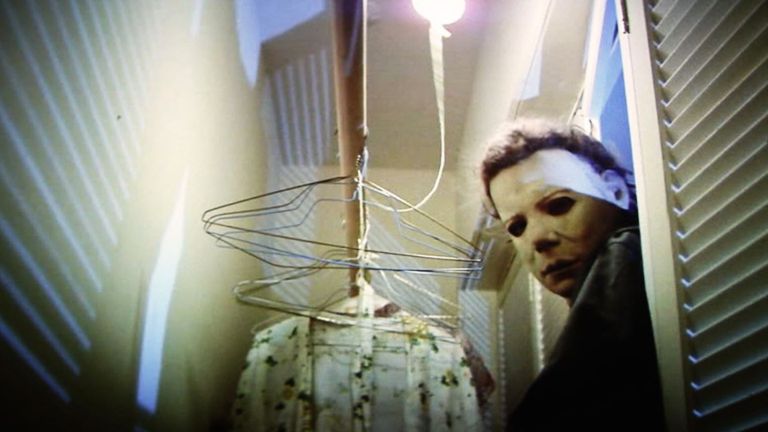
The Halloween movies make up the single most iconic horror franchise of all time. The movie’s villain, Michael Myers, is synonymous with “slasher movie killer,” and many of the tropes that originated in Halloween still appear in modern horror. This special little movie was written in just three weeks and filmed in 21 days on a budget of $300,000. It went on to earn $70 million and is one of the most financially successful films of all time. Here’s a deep dive into the history of Halloween and what makes the horror of The Boogeyman endure:
Origin story: Halloween (1978)
1. The budget for this independent movie, then titled The Babysitter Murders, was so small, director John Carpenter originally agreed to not take any pay for the film until it was profitable. He ended up getting a $10,000 fee for directing and a percentage of the film’s profits. Donald Pleasance was paid $20,000 for his role as Dr. Samuel Loomis, and Jamie Lee Curtis got $8,000 for playing Laurie Strode. Nick Castle, who played The Shape/adult Michael Myers, received only $25 per day that he was on set. It’s not known how much cowriter and producer Debra Hill made, but of her pay and not getting any of the film’s back end, Hill has said “If I knew then what I know now, I’d be rolling in it. I really resented it when [Halloween producer] Irwin Yablans drove up in a yellow Rolls-Royce and bought a yacht.”
2. For reference, the budget for the film’s sequel, Halloween II, was $2.5 million and 2018’s Halloween had a budget of $10 million. Jamie Lee Curtis was paid $100,000 for Halloween II (1980) and $5 million for Halloween H20 (1998). John Carpenter now reportedly has a net worth of $40 million.
3. Some of the ways the crew saved money to make Halloween on such a small budget were: using a friend’s Winnebago as a trailer for crew, reusing the same few bags of fake leaves (the movie was filmed in the springtime in California and was set in fall in Illinois) and using the actors’ own clothing and vehicles. A budget-friendly sound effect used for the murder scenes was the sound of a knife stabbing a watermelon. The Myers home was an abandoned building owned by a church. John Carpenter wrote the iconic theme and soundtrack himself, originally because he was the “best he could afford.” Carpenter’s father taught him to play piano, but he couldn’t read music at all. Still, he wrote the simple Halloween theme in an hour and the entire soundtrack in three days.
4. It helped that the film’s entire concept was built with a shoestring budget in mind. Irwin Yablans had the original idea for Halloween. He said, “I was looking for an idea that wouldn’t cost money because I didn’t have any money. I couldn’t afford to buy a book or a play. And it happened to be Halloween night.” John Carpenter and Debra Hill wrote the script, and Yablans and Moustapha Akkad provided the cash.
5. Debra Hill’s original description of the project should have sold any financier on it. The last few lines are straight out of a Don Draper pitch on Mad Men.
“The idea was that you couldn’t kill evil, and that was how we came about the story. We went back to the old idea of Samhain, that Halloween was the night where all the souls are let out to wreak havoc on the living, and then came up with the story about the most evil kid who ever lived. And when John came up with this fable of a town with a dark secret of someone who once lived there, and now that evil has come back, that’s what made HALLOWEEN work. We didn’t want it to be gory. We wanted it to be like a jack-in-the box.”
Debra Hill, to Fangoria
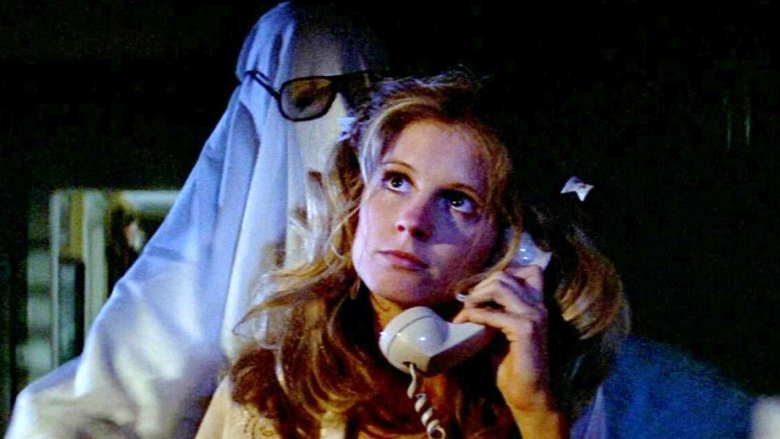
6. Moustapha Akkad said he decided to take a risk on a young filmmaker because he wanted to make a horror film as good as The Exorcist. Akkad told Fangoria he was excited about the project for two reasons: “One, Carpenter told me the story verbally and in a suspenseful way, almost frame for frame. Second, he told me he didn’t want to take any fees, and that showed he had confidence in the project.”
7. The relationship between John Carpenter and his then-girlfriend Debra Hill is interesting if you want to understand the mechanics of how women’s contributions to the film industry (and all fields) have been misunderstood in history. It’s not that as a writer and producer Debra Hill was just as influential in creating Halloween as John Carpenter was as the director; it’s that she contributed almost as much and received way less than “almost as much” money and notoriety. History tends to recreate successes as a winner-take-all enterprise. This means that the work of people who don’t captain the ship is usually forgotten, and we end up saying things like “we need more women in horror” not realizing that women have always been writing and creating horror. We just tend to not hire them for leadership roles or hold the work they do in similar esteem.
For instance, John Carpenter is frequently described as Hill’s “mentor” when he was only two years older than her and had only a handful of years of experience in the industry when they met. In the same way, Debra Hill once hired James Cameron to do special effects on another film she was producing. No one refers to Debra Hill as James Cameron’s “mentor,” even though Cameron himself says Halloween inspired him to write The Terminator (1984). Debra Hill was involved in every facet of Halloween‘s creation. She wrote the script with Carpenter, including all of the dialogue between the female cast members. The accuracy of the film’s teenage vernacular is one of the things that has been credited with attracting such a big audience. The name of Michael Myers’s town, Haddonfield, comes from Haddonfield, New Jersey where Debra Hill grew up. Another big factor in Halloween‘s success was casting OG Scream Queen Janet Leigh’s daughter as Laurie Strode. This was also Hill’s idea. Carpenter wanted Annie Lockhart from Lassie.
For his part, John Carpenter seemed to be looking out for his girlfriend. He made sure Hill was named producer of the project before he signed on. Though she never had the name recognition or wealth of Carpenter, Hill went on to become a well-respected producer in Hollywood and spoke candidly about how unfriendly the industry can be for women.
8. Laurie Strode was the first film role Jamie Lee Curtis ever got. It was her big break, but as the daughter of two major Hollywood actors, Janet Leigh and Tony Curtis, she didn’t really need one. Jamie Lee Curtis appeared in Halloween II (1981), Halloween H20: 20 Years Later (1998), Halloween: Resurrection (2002), Halloween (2018), Halloween Kills (2021), and will appear in Halloween Ends (2022). A fun horror fact about Jamie Lee Curtis is that she actually doesn’t like scary movies! Curtis is close friends with Sigourney Weaver but has never seen the end of Alien (1979) because it’s “too scary.”
9. Of taking a chance on the role of Dr. Loomis, Donald Pleasance said: “The only reason I’m doing this movie is because I have alimony to pay, and my daughter in England is in a rock ‘n’ roll group and she said the music that [John Carpenter] did for Assault On Precinct 13 is cool.”
10. For a slasher movie, Halloween isn’t gory. There’s almost no blood in the entire movie. When preparing the crew for Halloween II, Debra Hill wrote, “People don’t seem to realize that we showed next to no blood in the first picture. You think you’re seeing a lot more than we’re showing you.”
11. One reason for the lack of blood was the backlash John Carpenter received for his previous film, Assault on Precinct 13 (1976), when child actress Kim Richards’s character was killed on screen. Coincidently, Kim Richards’s sister, Kyle Richards, was cast as Lindsey Wallace in Halloween and reprised her role in Halloween II. The third “Richards sister” is Kathy Hilton, mother of Paris and Nicole. All three women have been cast members of the reality TV show The Real Housewives of Beverly Hills. Kyle Richards returned to the Halloween franchise in 2021’s Halloween Kills as adult Lindsey Wallace. She can be seen getting reacquainted with Michael Myers in the film’s trailer:
12. This scene is a great example of what film nerds love about Halloween. It was only the fourth movie to use a camera rigged to make the audience feel like they’re in the killer’s POV. A Panasonic Panaglide was used as the actual equipment that created this kind of shot, but the movie was influential in getting filmmakers to use a similar technology (the Steadicam). Stanley Kubrick’s The Shining came out two years later and heavily featured use of the Steadicam.
13. Halloween premiered on October 24, 1978 in Kansas City. Viewers loved the movie, word of mouth spread, and after a few months, glowing reviews from big-name critics such as Roger Ebert started coming in (early critics didn’t like it). Gene Siskel said the movie was so scary he took a cab home from the theater instead of walking two blocks in the dark. The limited release turned into a national one. Eventually the movie became a huge box-office success and the highest-grossing independent film ever made at the time.
Michael Myers: the mythology of the man in the mask
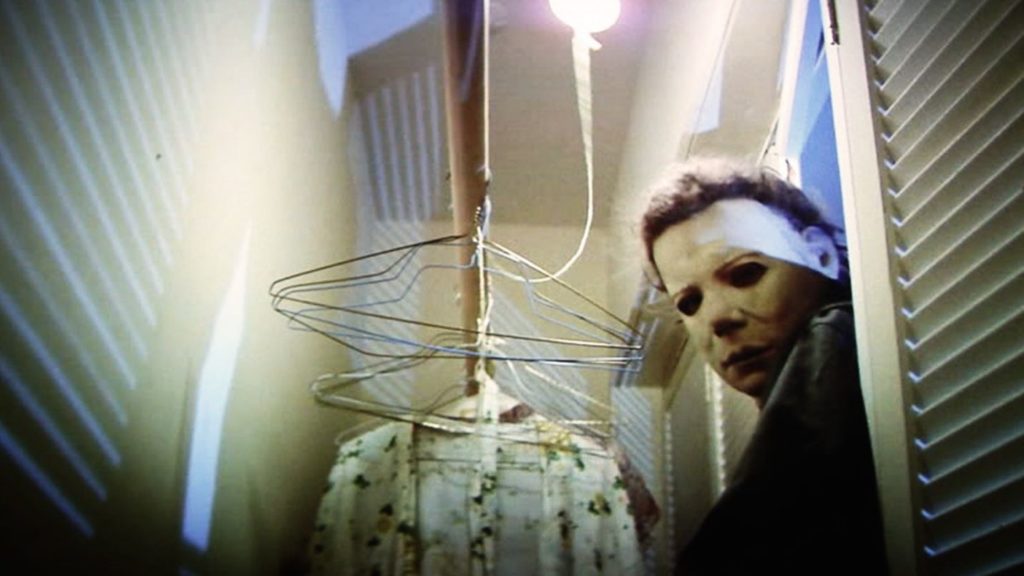
14. Halloween is nothing without antagonist Michael Myers. The original idea of the character was an urban legend come to life. Haddonfield, like most towns in America, has its own dark history and gossip about what has gone on in the past. At the tender age of six, an expressionless Michael Myers stabbed his sister to death, as shown in the opening scene of Halloween. He is then institutionalized at Smith’s Grove Sanitarium and for 15 years the mythology of Michael Myers was told over and over in the town of Haddonfield. We are shown that kids in town cross the street when they pass by the Myers house. What Carpenter and Hill wrote in the Halloween script was a story about what happens when a town’s boogeyman turns out to be real and comes home. This theme is revisited in 2021’s Halloween Kills, which focuses on the town of Haddonfield and their anger toward the man in the mask who has terrorized them for decades.
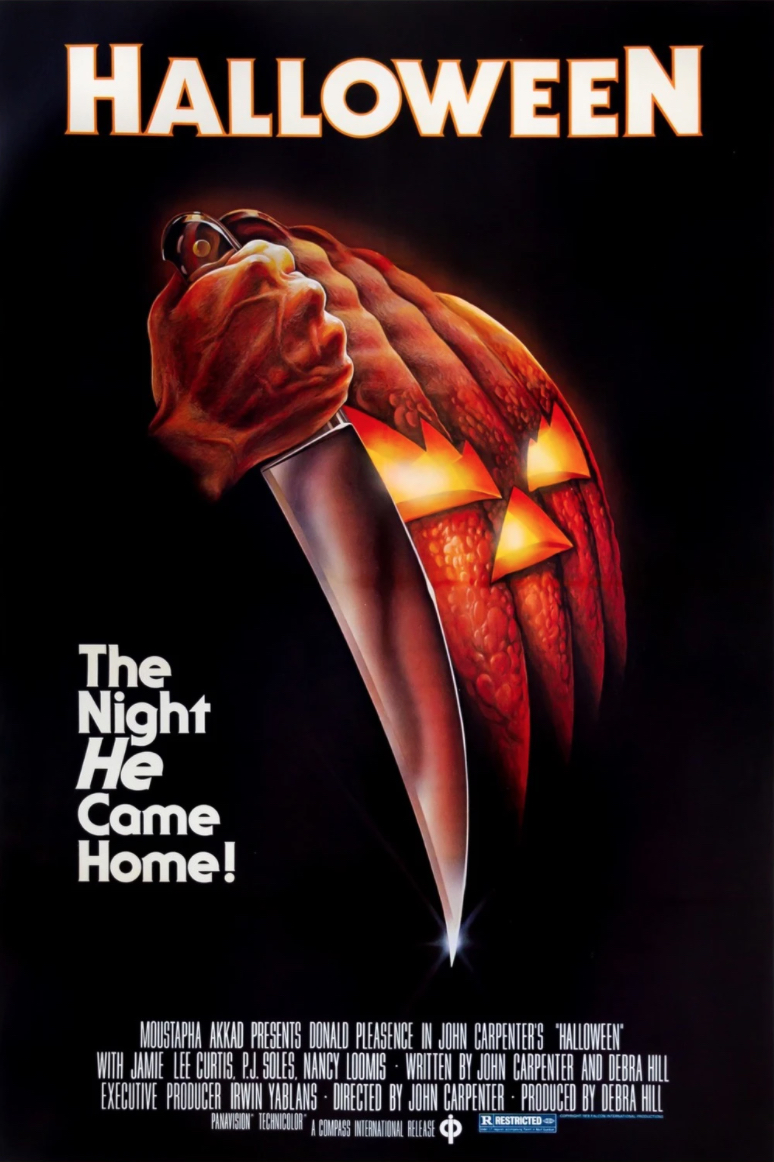
15. The idea of Michael Myers evolved out of the unseen killer in Black Christmas (1974), a slasher movie about an escaped mental patient who returns to his hometown and kills a bunch of teenagers. Sound familiar? John Carpenter liked the concept so much he approached the director, Bob Clark, about making a sequel.
16. Carpenter was also inspired by a childhood experience where he visited a psychiatric hospital and met a child who “looked evil” and stared at him. This might be the basis of a direction he gave cast and crew about the character of Michael Myers: “the audience should never be able to relate to him.” In one famous scene where Myers kills the character Bob Simms, Carpenter instructed Nick Castle (the actor playing Myers) to pin his victim to the wall with a knife and then gaze at him like a “pinned butterfly” he had just added to his insect collection.
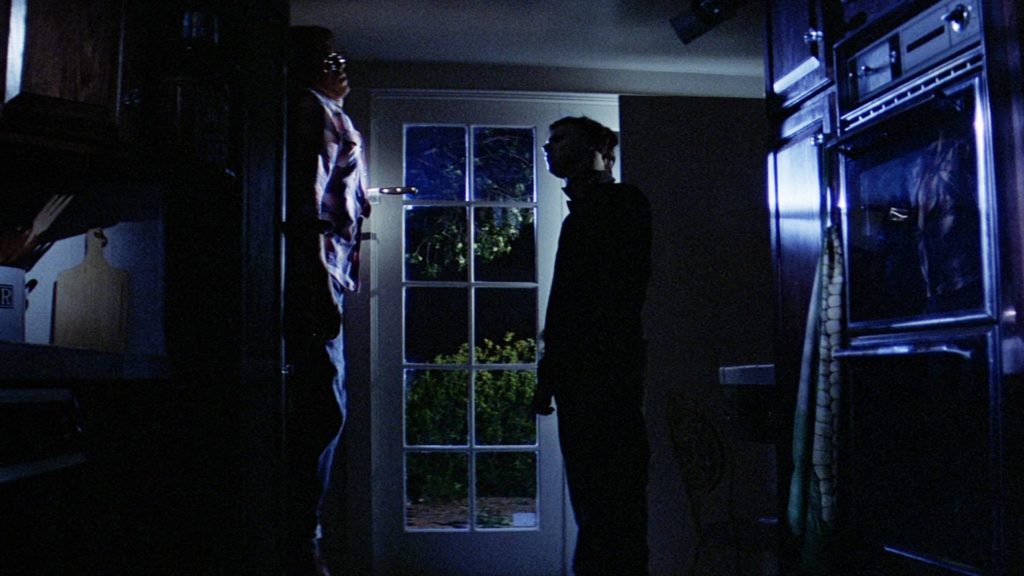
17. Michael Myers is often referred to as “The Shape,” a name that comes from the Salem Witch Trials where it was used to mean an evil ghost. Not much is known about how a kid from Haddonfield became The Shape. Michael Myers clearly possesses superhuman strength and the ability to survive, but when he murdered his sister as a six-year-old, he was a small child. Producer Debra Hill used her hands to stand in for Michael in the killer’s POV shots because she had the smallest hands of everyone on the crew. At times Michael seems like he isn’t sentient, but at other times he demonstrates intelligence, like at the beginning of Halloween Resurrection when he outsmarts Laurie Strode by manipulating her fear of killing the wrong man (again). Dr. Loomis implies that Michael can’t be killed because he is so evil that “hell won’t take him.”
18. The name “Michael Myers” came from the name of the head of Miracle Films, the studio that distributed Carpenter’s film Assault on Precinct 13 (1976). Carpenter used the name as a thank-you to the real Mr. Myers.
19. In Halloween, it’s shown that Michael Myers can drive a car despite being institutionalized at the age of six. A novelization of the film says that Michael was so intelligent he learned to drive just from watching. In Halloween: H20, it’s hinted that someone at the hospital gave him driving lessons. Another fun fact from the novelization: Michael’s middle name is Audrey.
20. The first idea for Michael Myers’s costume was an Emmett Kelly clown mask. The crew knew they didn’t have money for an original mask, and the script description was just that Myers wore a mask with “pale facial features.” Production approached a famous Hollywood mask-maker asking if they could get a free mask in exchange for thanking the company in the film’s credits. The mask company got similar offers all the time and declined, though obviously in hindsight this would have been great publicity. Famously, the crew found a William Shatner mask and modified it with blue-white spray paint and scissors into the iconic “face” of Michael Myers. The Shatner mask was purchased for $1.98 at a costume shop.
21. Michael Myers’s birthday is October 19, 1957. This makes him a Libra. Real-life serial killers born under this sign include Pedro “Monster of the Andes” Lopez, Fred West, and Andrei Chikatilo.
22. While institutionalized at Smith’s Grove Sanitarium, Michael is cared for by Dr. Samuel Loomis. Throughout the Halloween movies, Dr. Loomis appears to warn others about how dangerous Michael Myers is, saying he is the most dangerous patient he has ever encountered. The name “Sam Loomis” comes from one of the main characters in Psycho (1960). Dr. Loomis worked with a nurse named Marion Chambers, a combination of the name of Sam Loomis’s girlfriend and the sheriff in the Hitchcock film.
I met him fifteen years ago. I was told there was nothing left. No reason, no, uh, conscience, no understanding and even the most rudimentary sense of life or death, of good or evil, right or wrong. I met this six-year-old child with this blank, pale, emotionless face, and the blackest eyes, the Devil’s eyes. I spent eight years trying to reach him and then another seven trying to keep him locked up, because I realized that what was living behind that boy’s eyes was purely and simply evil.”
Dr. Samuel Loomis in Halloween
23. A Halloween fan theory suggests that the reason Michael Myers seems to have an inhumane pain threshold is he may be suffering from congenital analgesia, a rare condition in which a person doesn’t feel pain at all. They are just as mortal and easily injured as the rest of us, but because they don’t feel pain their unawareness of what injures them can come across as superhuman strength. Another theory posits that perhaps Dr. Loomis is the real bad guy in the original.
The Halloween universe
24. The Halloween universe is famously confusing because there are so many sequels and some of them disavow others. Basically, everyone agrees the original Halloween is canon and Season of the Witch is not canon. Beyond that, it goes movie by movie:

25. Initially, John Carpenter was resistant to the idea of creating a sequel, much less an entire Halloween universe. This is one reason the trajectory of the first movie doesn’t quite fit with what the franchise became, especially Halloween III (1982), which is a standalone anthology movie. It’s also why there is no mention of Laurie Strode being Michael Myers’s sister until the sequel. It was added to the plot of Halloween II to explain why Michael follows Laurie to the hospital. The story became that Michael was obsessed with his sister and escaped the sanitarium to get to her. Michael was hiding out at the now unoccupied Myers house where he saw Laurie Strode dropping off a key and recognized her as his sister. He then follows Laurie and her friends around and starts murdering them.
26. In 1981, John Carpenter shot 12 additional minutes of footage for the original Halloween so that it could be aired on a two-hour time slot on NBC. He did this while Halloween II was filming.
27. Halloween II (1981) was groundbreaking in that it takes place only five minutes after the original film ends. John Carpenter and Debra Hill returned as cowriters, though Carpenter declined to direct again. Their first idea was to set the sequel a few years after the events of Halloween with Laurie Strode living in an urban condo building. Eventually the setting was changed to the Haddonfield hospital where Laurie is recovering from her injuries.
28. On December 7, 1982, a man murdered an elderly couple in Fullerton, California. During his trial, he said he committed the murder because he watched Halloween II after consuming PCP, marijuana, and alcohol. The entire movie was screened during the trial where defense tried to blame the film for the gruesome crime. The elderly couple, Francis and Eileen Harbitz, was stabbed 43 times. The man accused was found guilty and convicted of murder.
29. Carpenter and Hill planned for Halloween II to complete the story of Michael Myers and Laurie Strode. This is why Halloween III: Season of the Witch (1982) isn’t about Michael Myers at all. The plan was that the Halloween name would continue as an anthology series (similar to what American Horror Story did, covering a new story each season). People hated the idea when they discovered they were watching a movie about witchcraft, not Michael Myers. However, Season of the Witch‘s legacy as a standalone horror movie has improved since its release.
30. Halloween 4: The Return of Michael Myers (1988) focuses back on the Michael Myers saga, as the previous movie was such a bomb. Michael wakes from a coma when he hears that Laurie Strode has died and left a daughter, Jamie Strode, in Haddonfield. Michael escapes and once again returns to his hometown to hunt for his relative. At the end of the movie, Michael escapes from an angry mob, and his injured body is washed downriver. A hermit stumbles across the unconscious body of Myers and cares for him until he regains his strength and wakes from the coma.
31. In Halloween 5: The Revenge of Michael Myers (1989), Michael recovers from his injuries and kills the hermit who nursed him back to health. He then returns to Haddonfield to look for Jamie Strode, who is now hospitalized as a result of touching Michael and being negatively impacted by proximity to evil. She also has a psychic connection with him and can “see” what he is doing.

32. Halloween 6: The Curse of Michael Myers (1995) stars Paul Rudd in one of his first film roles along with Clueless, which also released that year. Rudd plays Tommy Doyle, one of the boys Laurie Strode was babysitting in Halloween who grew up to be obsessed with Michael Myers. Since the events of the previous movie, Jamie Strode was kidnapped and raped. At the beginning of the movie, she gives birth and attempts to escape but is killed by Michael Myers. Relatives of the Strode family have also moved into the old Myers house, and Danny Strode, a young boy, begins to hear violent voices. As Michael attacks the Strode family, Danny and his mom escape to Tommy’s house, and Tommy tells them his theory that Michael gets his power from a Druid cult.

33. Halloween H20 (1998) reveals that Laurie Strode faked her own death to escape Michael. She had a son named John and cut off all contact with her former life, assuming a new name and becoming the headmistress of a private high school her son attends. Michael tracks her down, breaking into the house of Dr. Loomis’s nurse, Marion Chambers. He leaves Illinois for northern California and tries to kill Laurie, her son, and everyone else he comes into contact with. In the end, it appears Michael is finally killed by his sister.

34. Halloween Resurrection (2002) shows that Michael survived the events of the previous film and Laurie Strode is now institutionalized over the trauma of killing an EMT who she believed was Michael. Back in Haddonfield, a reality TV crew is getting ready to film a Halloween special in the old Myers home. Michael shows up and things get pretty murderous.
35. An idea for Halloween 9 was a movie about Michael Myers and Pinhead from Hellraiser (1987) battling in the vein of Freddy vs. Jason (2003). Clive Barker was going to write a script, and John Carpenter was even thinking about directing. However, horror fans didn’t respond well, and the project was dropped. There was also a script called Halloween: The Missing Years that was never made. It would have been a prequel to the original.
Rob Zombie’s Halloween
36. In 2007, a heavy metal musician with a famous love for horror movies wrote and directed his own vision of what Halloween should look like. Though Rob Zombie’s favorite horror movies are pre-code, he grew up watching Halloween and its endless sequels. Zombie’s Halloween (2007) and Halloween II (2009) add more to the origin story of Michael Myers and how he came to be a super-strong, impossible-to-kill embodiment of evil. They’re also significantly more violent than the originals.
37. Before announcing the project, Rob Zombie talked to John Carpenter about remaking his work. He says Carpenter told him to make the films his own. Zombie’s movies disregard everything in the Halloween universe and simply exist on their own as an alternate version of the story. Carpenter and Zombie are respectful of each other’s work but disagree on the fundamental character of Michael Myers. Zombie tried to show how humans can become as evil as Myers, while Carpenter sees him as “almost supernatural.” One thing Carpenter and Zombie agreed on is the plot that Laurie Strode and Michael Myers are siblings, an aspect cut out by the Halloween Ends reboot trilogy.
38. PETA said they appreciated Rob Zombie for including animal abuse as part of Michael Myers’s origin story, because in real life people who abuse animals also tend toward other kinds of violence.
39. Halloween (2007) is Rob Zombie’s most successful film, earning $30.5 million in its opening weekend. To this day it is the highest-grossing movie to release on Labor Day weekend. Zombie then announced he would create a remake of The Blob (1958) but later decided he didn’t want to do another remake, and the project was eventually abandoned.
Halloween Ends reboot trilogy
40. Bob Weinstein tried to make a found-footage Halloween movie called Halloween 3D in 2010 and again in 2014, but it never got off the ground.
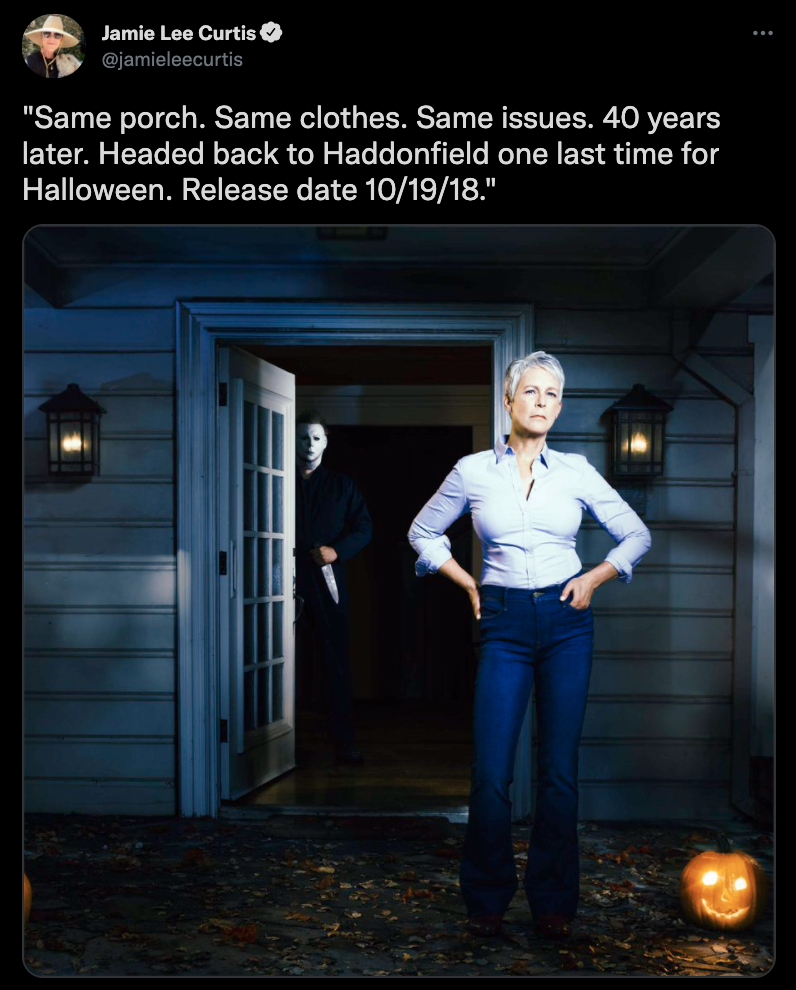
41. David Gordon Green and Danny McBride, filmmakers and fans of the Halloween franchise, pitched an idea for a direct sequel to Halloween (1978) to Blumhouse that become the Halloween reboot trilogy. In 2016, John Carpenter agreed to executive-produce the project and also wrote the score. Set 40 years after the events of the original, Halloween (2018) follows Michael Myers as he escapes from a bus while being transferred to a maximum-security prison. Laurie Strode is now an elderly woman living with PTSD and a stockpile of weapons on the outskirts of Haddonfield. Michael Myers tries to kill her, her daughter, and her granddaughter. Jamie Lee Curtis and Nick Castle reprised their roles as Laurie Strode and Michael Myers.
I always knew he’d come back. In this town, Michael Myers is a myth. He’s the Boogeyman. A ghost story to scare kids. But this Boogeyman is real. An evil like his never stops, it just grows older. Darker. More determined. Forty years ago, he came to my home to kill. He killed my friends, and now he’s back to finish what he started, with me. The one person who’s ready to stop him.
Laurie Strode in Halloween (2018)
42. In the original Halloween universe, Laurie Strode has a daughter named Jamie Lloyd who appears in Halloween 4-6. Because Halloween (2018) only considers the original to be canon, Jamie Lloyd is never mentioned. Laurie does have a daughter in this universe, but her name is Karen Nelson. Also, in this universe Laurie and Michael are not related.
43. Halloween Kills (2021) takes place immediately following the events of Halloween (2018) when the Strode women leave Michael Myers burning in the secret basement of Laurie Strode’s home. As is his custom, Michael is not actually dead and murders the first responders who show up to put out the fire before setting off in search of Laurie.
44. Halloween Ends is planned to be released in October 2022.
Halloween‘s legacy and impact on the horror genre

45. Along with The Texas Chain Saw Massacre and Black Christmas, Halloween originated the concept of the “final girl.” In a slasher movie, a final girl is the heroine who makes it all the way to the final scene. In Halloween, this is Laurie Strode.
46. One element of a final girl is supposed to be that she is morally superior to the other people in the movie; for instance, most final girls don’t drink or have sex, leading to the “virginity rule” of early slasher films. The virginity rule implied that characters who are shown to be sexually active in a horror movie will be later killed by the villain. John Carpenter and Debra Hill have tried to correct a mistaken belief about this particular legacy of Halloween. They have both said that the real reason there’s sex and drugs in horror movies (which the final girl usually does not partake in) is because there’s so much sex and drugs in real life, and in horror movies you need a way for people to get separated so that the villain can kill people. They viewed sexuality as a plot device, not as a veiled threat about the dangers of immorality.

47. This is especially true because so many people seem to think Michael Myers is a justice dispenser who kills babysitters as punishment for the babysitters not paying enough attention to the kids. (Remember, babysitting is so central to the film it was almost titled The Babysitter Murders.) This intersects with another horror trope, “The Babysitter and the Man Upstairs,” a popular urban legend in which a babysitter is tormented by mysterious phone calls until eventually police trace them to a man upstairs and warn her that “the call is coming from inside the house.” The urban legend is meant to warn babysitters to pay attention to the children in their care, which is a weird lesson considering the stereotypical babysitter is a young teenage girl who has been left in charge by the children’s actual parents who are going out for a night on the town. This results in the morality lesson being a double standard between what the children’s parents are allowed to do (be human, take a break) and what we teach young girls they are allowed to do (be a perfect caretaker or you will die).
48. The origins of “The Babysitter and the Man Upstairs” urban legend probably comes from the murder of Janett Christman in 1950. The 13-year-old was babysitting for a family friend when she was murdered (probably by another “family friend” who knew she was babysitting alone and previously expressed a sexual interest in her). Nothing in the story of Janett Christman implies that she would still be alive if she took better care of her charge, or even that she wasn’t a good babysitter at all. Like many tragic stories, retellings of it can obscure what really happened in favor of whatever the teller wishes to project onto the story. It is likely that the origin of both the virginity rule and the “Babysitter and the Man Upstairs” urban legend is the human tendency to victim-blame and conflate weakness or vulnerability with “asking for it.”
50. Another horror trope popularized by Halloween is that its villain appears to be immune to bullets. A related trope is that Michael often seems to die, only to come back after the final girl thinks it’s over for another scare. These tropes are explicitly referenced in many other horror movies, including Scream 3 when horror nerd Randy Meeks posthumously tells Sidney Prescott that in order to kill Ghostface she will need to take drastic action: “Stabbing him won’t work. Shooting him won’t work. Basically in the third one you gotta cryogenically freeze his head, decapitate him, or blow him up.”
51. In Halloween, Michael Myers appears to only wear one outfit. We are shown how he kills a man for his uniform and finds the mask, but never him washing his clothing or wearing something else. There’s also no explanation given for why he chose this particular outfit or mask or why he wears the same thing for 40+ years. Later horror franchises such as Friday the 13th also feature the “one outfit” trope while other slasher villains wear masks or costumes to allow themselves to conceal their identity and kill anonymously. This isn’t Michael’s motive, however, as he is identified as the killer by name throughout the entire movie, beginning with the first scene.
52. Dating all the way back to Greek mythology, the “Cassandra” trope is named for a cursed priestess who has real visions of the future but is unable to get people to believe her or act on her advice. Dr. Loomis is the Cassandra character in Halloween, always showing up to (unsuccessfully) warn the people of Haddonfield about the danger of Michael Myers. Other “Cassandra” characters are Carrie Matheson in Homeland and Fox Mulder in The X-Files.
53. A final note on “final girls.” Film professor Carol J. Clover has written about the history of this trope. She believes that the reason final girls became a thing at all was because of the discomfort audiences would feel watching a man be terrorized throughout the film since it’s so far away from the male gender role and how we are used to perceiving men as strong and stoic. This is slowly changing as more movies show male terror. The actor who played Christian in Midsommar (2019), Jack Reynor, chose to be fully nude in the scene where his character is raped and then runs around a Scandinavian commune in distress because of the trope of final girls and the frequency with which distressed women run around naked in horror movies.
